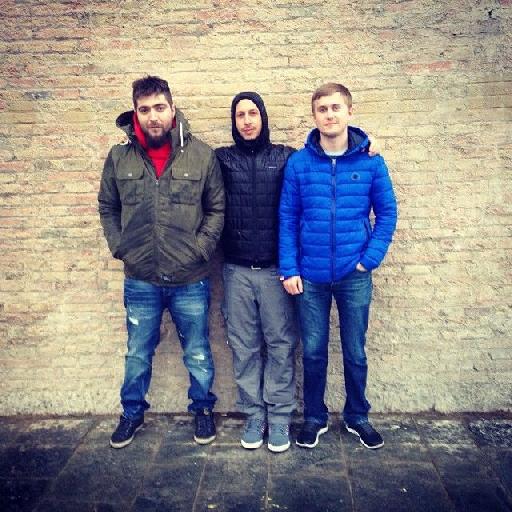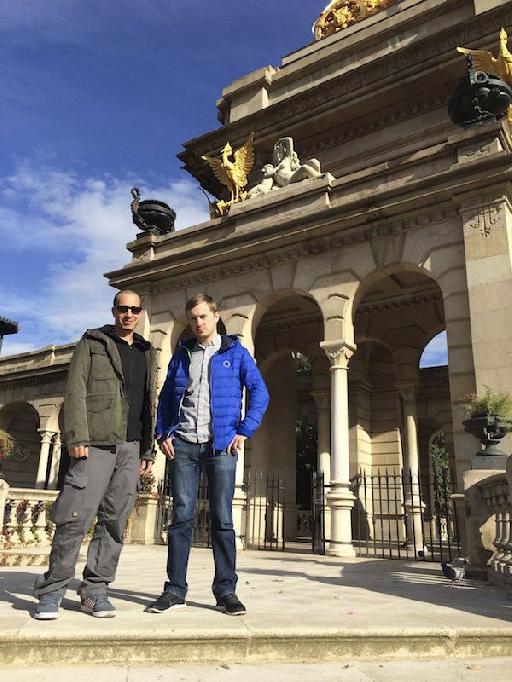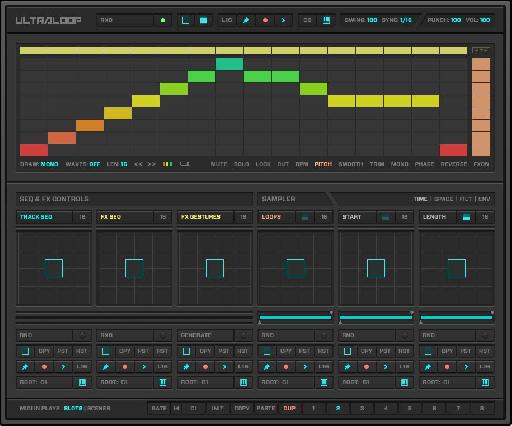How did you and Igor start Twisted Tools?
I contacted Igor online in 2008 after having discovered his amazing Reaktor work in the Native Instruments User Library. I ended up hiring him to develop a custom instrument I had in mind and we hit it off. In February of 2010, Igor contacted me to ask if I'd be interested in teaming up with him to launch a business selling instruments. At the time, I was the Director of Computer Music Production at a digital arts college here in San Francisco and Igor had just graduated college. We decided to go for it and as things evolved, it began to look like there was a market for these devices, so we eventually decided to pursue it full time.
What's your underlying philosophy behind creating Reaktor effects as opposed to regular VST/AU plug-ins?
First, to clarify things, Reaktor is a VST/AU plug-in by Native Instruments and is basically a shell for the things you program inside of it, which are called Ensembles. The Ensembles can be programmed, but rather than using text to code, you are using a more modular approach by visually cabling objects together. The user doesn't have to see any of this though, so they are basically the same thing at the end of the day, though there are certainly some nuances.
The main obstacle for people with Reaktor seems to be the price of entry and the small learning curve. Yes, it's not cheap to buy Reaktor on its own, but you can get it as a part of Komplete where it's a bargain. On the one hand, it's a bummer that you have to own Reaktor in order to use a single Reaktor ensemble, but owning Reaktor gets you access to the amazing factory content and the Reaktor User Library which has literally thousands of free instruments! You can think of buying Reaktor as a one-time membership fee for some true desert island music software.
Many instruments in the Reaktor User Library are top quality devices that sound amazing and would cost you a ton of money as a standard VST/AU standalone app! So if you look at it from that angle, it's a steal. Plus, you can build your own software or tinker to make your own tools that suit your needs. In that sense, Reaktor is like a super VST/AU and a vehicle for fast, effective prototyping or full-fledged plug-in development. However, it can definitely get tricky and some pretty basic things in Reaktor can be a bit of a challenge, but if you have a bit of patience the rewards are worthwhile.
Antonio, Josh & Igor form Twisted Tools.
Does this level of customisation contain any benefits beyond these?
For the typical Reaktor user the basic interface elements and concepts are consistent across all ensembles. Once you've learned how to do some really basic things, you can apply what you've learned to any other Reaktor ensemble. For example, let's say you want to flip through presets, but you want the Filter knob in an instrument to always stay locked in the same spot. You can tell Reaktor to 'Snap Isolate' that parameter for that knob, so that it won't be affected by preset changes. Then you can flip through your presets and hear what they sound like with the same Filter knob position! That technique works with almost any Reaktor knob and using any Reaktor instrument. It's just not possible to do with most standard VST/AUs. So for the end-user, there is a real benefit in terms of flexibility and customization.
There is a learning curve, but it's not as steep as people think. The simplicity of building excellent instruments using the pre-configured primary modules and macros is unrivaled. I'm not a programmer and I've figured it out enough to do most of what I'd like it to do without resorting to asking Igor for help.
Tell us more about the challenges or differences for you as developers.
As developers, the main difference between building within Reaktor and building a standalone VST/AU plug-in is that we don't have to spend as much time testing or developing the basic components and can focus on the main content of the plug-in itself. I don't think it would have been possible to build the instruments we've made had we not been working in Reaktor. We do so much improvising, testing and building as we go and Reaktor really lends itself to that.
Josh and Igor are based in USA and Europe respectively, so working remotely makes Twisted Tools tick.
There are a bunch of pre-integrated tools that come with Reaktor, such as the built-in recorder which allows users to record internally and drag-and-drop the results as a WAV into their favorite program. It's something we don't need to mess with when we're building, but it enhances every instrument we make. Another example would be the Snapshot (preset) system, which integrates seamlessly into any ensemble you're building on-the-fly. NI takes care of the meat and potatoes stuff like that and we can focus on being creative. The downside to this is when customers request changes to those meat and potatoes elements and that stuff is beyond our control. It can be a challenge for the customer to understand which elements of the design we are responsible for and which elements NI is responsible for. We have our share of issues with Reaktor too, but fortunately NI has a truly excellent team and they're very receptive to feedback.
Ultraloop was launched earlier this year and we can't get enough of its creative possibilities. Tell us more about how you both went about designing it.
Thanks! We've been using Ultraloop daily for over a year now as we developed it and we're still not tired of it, so I guess that's a good sign.
To be honest, I never was a loops guy. I didn't like the idea of using things that everyone else had. We set out to create an instrument that makes it easy, fun and creative to generate new loops from your existing loop libraries, so that you have an endless supply of unique content. Ultraloop takes your loops and makes new loops from them in a way that's almost as easy as downloading a new loop library itself'"it's certainly more fun. You can go nuts hitting random and 9 out 10 times it makes something musically coherent, which you don't get from a lot of other 'random' tools on the market. We spent a lot of time making sure that it's very hard to make something sound bad with Ultraloop, but also provide users with enough controls to be super deliberate about what they're making if they wish.
Ultraloop user interface.
All our tools are designed to help users achieve a meaningful result and to have fun in the process. It doesn't matter if you understand every detail because the instruments we make are hopefully designed in a way that inspires clicks in all the right spots. Ultraloop is no exception. It basically gets out of your way if you don't understand what you're doing and you can go nuts with it for hours coming up with insane new loops. Once you get to know it and you start to demand more of it, chances are we've been there already and made sure that it can handle most of your advanced requests. And if we've overlooked something, shoot us an email and we'll see if we can add it to our update list!
I think Ultraloop can be used by anyone interested in quickly generating new rhythmic patterns. Whether you're looking to remix loops from a song, make new hi-hat patterns from existing hi-hat pattern samples or simply randomly create song seeds to get an idea going, Ultraloop has something for you.
The included content in Ultraloop is very impressive. Tell us how this was made.
Thanks! We owe a major debt of gratitude to all the guys from the Enig'matik, Sounds of Revolution and Loopmasters labels who contributed content for Ultraloop. The default Factory map is all from Enig'matik records and we were very involved in that process, as those loops were created specifically for use within Ultraloop.
I got in touch with Jake Rose from Enig'matik who put together a stellar team of sound designers to work with us on the default map. We basically told them what we were looking for and gave them a bunch of our sample libraries to use as source material. They'd make a bunch of loops, put them in a Dropbox folder that everyone shared. We'd take the loops as they came in, throw them into Ultraloop and totally mash them all up and then send them back to the Dropbox for further tweaking. As soon as all the content was in, we compiled the maps and created the snapshots in-house.
We also developed three separate Ultraloop Loop Expansion packs for the release as well. Si Begg, Dusty Fungus and Chris Carter each did one and they turned out great. These expansions come with snapshots (presets) and loops, but you can use the snapshots with your own sample content or mix and match the different expansions. The results sound great because of the way Ultraloop is designed to handle loop recycling in a musical way.
With the analog trend truly kicking in in 2013 and being realized even more this year in software emulations, where do Twisted Tools sit in the mix?
Well, we make tools that simply don't exist or don't make sense in the analog world. It would be pretty expensive to buy modules that do what the Twisted Tools stuff does, but they'd sure be fun. In that sense, I'd say our stuff fits right in with the analog synth fan and they're certainly not mutually exclusive clubs.
Modulars are still pretty expensive for most people and require a ton of space! For people who can't afford them or fit them in their home without a domestic dispute about the living room being overrun with cables, you can buy sample libraries that get you some similar sounds in a neat tidy package. While it's not the same as owning your own modular, you can then process them and tweak them using software to get you some unique original sounds. Some of our sample packs feature analog modular sounds and our tools can be used to modulate them or process them, so in that sense we fit right in.
Also, you can use Reaktor to send out Control Voltage to your analog synths using Expert Sleeper's Silent Way or MOTU hardware easily enough, which means that anything we make with modulation can be used to drive your analogs. In fact, we made an app several years back that allowed you to send signals from Konkreet Labs Performer on the iPad to your modular via Reaktor. I think now that the analog craze has fully kicked in, we might pursue making some more tools like that which use Reaktor to interface with modulars.
Tell us about your decision in supporting Lemur and the iOS platform.
Well, since Antonio Blanca joined Twisted Tools we've been trying to make sure all our instruments get a Lemur template designed by Antonio, who is one of the leading Lemur developers in the world in my opinion!
Antonio does a fantastic job at creating templates that allow you to control our software from the iPad and our instrument designs are certainly taking that into consideration. I think the iPad is a great control source for desktop software. I'm not crazy about the iPad as a standalone instrument as much as I am a fan of using it to control or manipulate what's on the desktop. It's really good at that and super affordable.
For $24.99, you can get Lemur and control hundreds of different instruments using an iPad which is just insane! Lemur 5.0 just came out and features a new Object called Canvas which is going to open up a lot of doors in terms of what you can do with a Lemur. We're already working on some cool stuff that will take advantage of this. Oh and we just released a freebie called Morph Board which allows you to store, recall and morph any set of controls. Crazy stuff!
How do you anticipate musicians and producers will be using touch technology in a few years from now?
I'd say that in the future we'll see more and more interesting hardware controllers and tactile devices like the iPad, but with haptic feedback that's more interesting than simple glass.
Can you reveal anything about new products you're currently on?
Unfortunately, I can't say too much without spoiling things! However, I can mention that we plan to release more Loop Expansion packs for Ultraloop. But beyond that, all I can say is that we have a couple really big things coming and 2014 should be another good year for Twisted Tools.
Check out our review of Ultraloop here.
More about Twisted Tools here.






 © 2024 Ask.Audio
A NonLinear Educating Company
© 2024 Ask.Audio
A NonLinear Educating Company
Discussion
Want to join the discussion?
Create an account or login to get started!